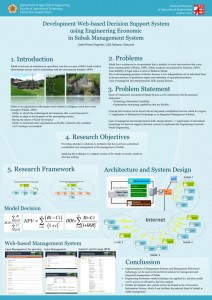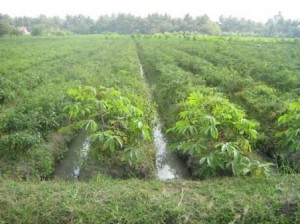Sep
14
2011

Subak is not only an institution in agriculture, but also as a part of Bali’s local wisdom about human society and its relationship with the environment. Subak as an organization with unique socio-cultural or religious social have some strengths, i.e; (i) ability to absorb the technological developments that evolved around it, (ii) ability to adapt to the dynamics of the surrounding culture, (iii) having the nature of Good Governance, and (iv) ability to restructure their organization as flexible, tailored to the condition of it’s strategic environment.
However, Subak is not free from weaknesses in its operations that is inability to resist interventions that come from external parties. It can be identified are (i) unavailability of legal status to most of Subak, (ii) the weak bargaining position of farmers because it acts independently on an individual basis in the procurement of production inputs and marketing of agricultural products, and (iii) lack of managerial and entrepreneurial skills among farmers.
The research objectives are providing alternative solutions to problems that have not been centralized coordination and management in the management of Subak, and applying the technique as a support system of the simple economic model in decision making.
The research was conducted by Andri Prima Nugroho, Lilik Soetiarso and Sumiyati, and funded by Ministry of Agriculture through KKP3T Program in Year 2010.
Sep
09
2009
 Recently, the main challenge in the development of agricultural industry sector is the limited presence of the natural resources of agriculture, both in quantity and quality aspects. One of the natural resources that significantly degrade is an agricultural land area. The research was conducted for identifying the capacity of coastal area as one of the natural resources to support development of an agro-industry through introducing agricultural innovation technology. In this stage, outputs of the research were an information system for managing those innovation technologies and profile of the farming system in coastal area.
Recently, the main challenge in the development of agricultural industry sector is the limited presence of the natural resources of agriculture, both in quantity and quality aspects. One of the natural resources that significantly degrade is an agricultural land area. The research was conducted for identifying the capacity of coastal area as one of the natural resources to support development of an agro-industry through introducing agricultural innovation technology. In this stage, outputs of the research were an information system for managing those innovation technologies and profile of the farming system in coastal area.
Research mechanisms include: (i) identification of system parameters through field observations, (ii) preparation of model development system, (iii) development of software-based GIS, (iv) validation and verification of systems with field data acquisition, and (v) standardization system. The developed model was tested in three districts in Province Yogyakarta, namely (i) Bantul, (ii) Kulon Progo and (iii) Gunungkidul. (published by Journal of Agritech 30(2) 2010 – Universitas Gadjah Mada)
Sep
04
2009
 The second part of the study was to validate the developed information system in a selected farming area. For the primary data, a farm survey was conducted in Sleman Regency, Yogyakarta Province. The sixty (60) household farms in 6 (six) districts were investigated which were grouped into animal based and tractor based farms.
The second part of the study was to validate the developed information system in a selected farming area. For the primary data, a farm survey was conducted in Sleman Regency, Yogyakarta Province. The sixty (60) household farms in 6 (six) districts were investigated which were grouped into animal based and tractor based farms.
Based on the farm survey, the results described that the total annual water surplus in the study area was 792 mm that reached from November to April and water deficit was 355 mm from May to October. There is also surplus situation of number of animal drawn and local equipment for land preparation in each district, but deficiency in number of power tiller and it’s matching tillage equipment. The sensitivity analysis indicated those yield and crop price are the most significant factor in determining the net return of the crop production system.
Sep
04
2009
 This study was undertaken to develop a computer program package for identifying a farming system that was focused in the water availability analysis, the optimizing of agricultural power and selected equipment and the sensitivity analysis. The computer programs for all models were developed and written in FoxBASE command language. Three databases were obtained from the farm survey i.e.; climate, crop and power. All these databases can be appended, edited, deleted or displayed by the users through a menu of database management system (DBMS). They were used to evaluate the utility of the computer programs as input data. The information system calculates the amount of monthly water surplus and deficit, the optimum number of agricultural power (animal or power tiller) and its matching implement required and also change in the net return of crop production system due to the change of input variables such as crop price, yield, and production material cost. The system output for each analysis can be presented in three options by screen, printer and file that can be accessed to another language.
This study was undertaken to develop a computer program package for identifying a farming system that was focused in the water availability analysis, the optimizing of agricultural power and selected equipment and the sensitivity analysis. The computer programs for all models were developed and written in FoxBASE command language. Three databases were obtained from the farm survey i.e.; climate, crop and power. All these databases can be appended, edited, deleted or displayed by the users through a menu of database management system (DBMS). They were used to evaluate the utility of the computer programs as input data. The information system calculates the amount of monthly water surplus and deficit, the optimum number of agricultural power (animal or power tiller) and its matching implement required and also change in the net return of crop production system due to the change of input variables such as crop price, yield, and production material cost. The system output for each analysis can be presented in three options by screen, printer and file that can be accessed to another language.



